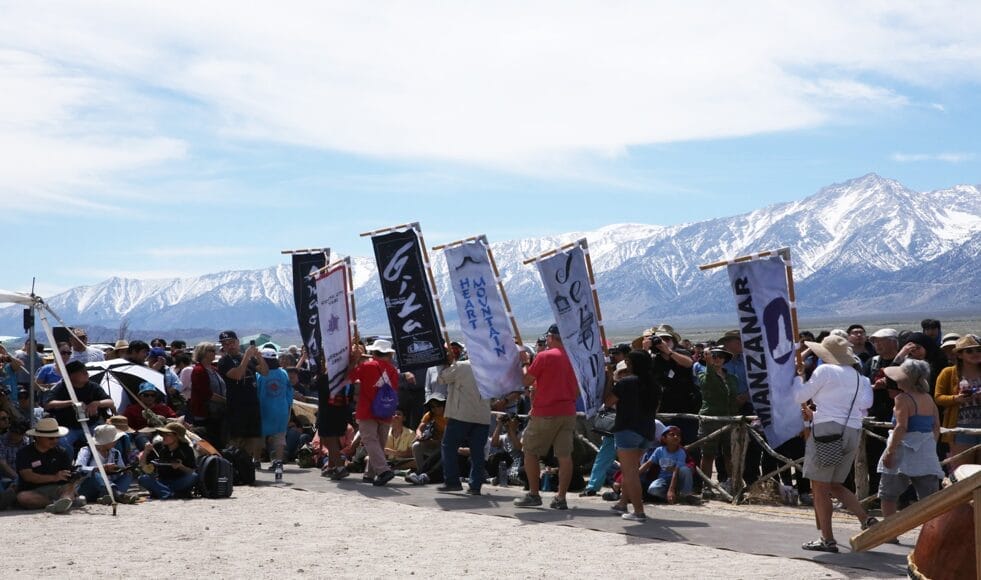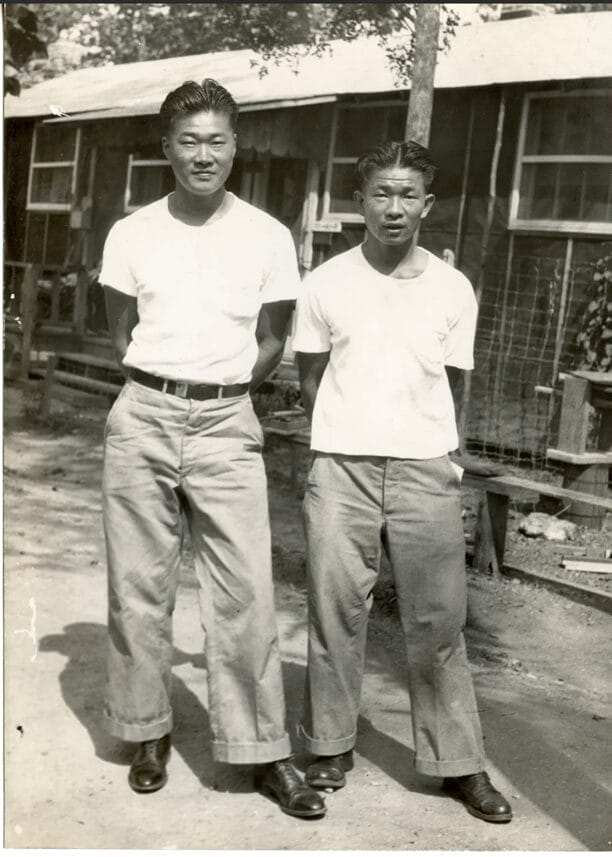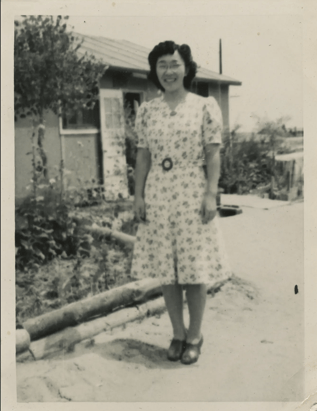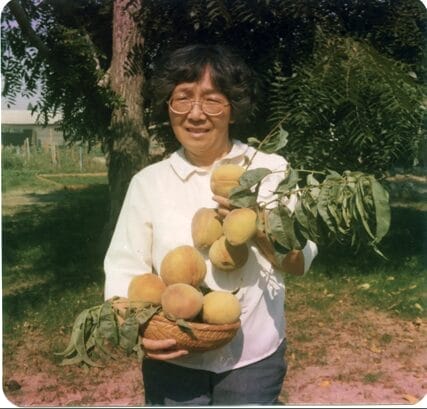
Kaneko family, 1933, probably just before Michi, Takeo, and Kimiko departed for Japan. From left to right: Takeo, Michi, Koki, Kimiko, and Michio. Courtesy of Ann Kaneko.
At the foot of the majestic snow-capped Sierras, the site of Manzanar, the World War II concentration camp, is the confluence for memories of Payahuunadü, the now-parched “land of flowing water.” Intergenerational women from Native American, Japanese American, and rancher communities have formed an alliance to defend their land and water from Los Angeles.
My paternal grandfather, Koki Kaneko, traveled from Fukushima, Japan, landed in British Columbia in 1906, then made his way to San Francisco and finally to Los Angeles. My paternal grandmother, Michi Tanabatake Kaneko, was a picture bride, who disembarked in San Francisco in 1914 and married my grandfather upon arrival. She came to Los Angeles, only to return to Japan because of health issues in 1933. During 19 years in Los Angeles, she gave birth to three children, the second of whom was my father, Takeo Kaneko, born in 1920. Michi took her two younger children, Takeo and Kimiko, to Japan. Takeo returned to Los Angeles in 1939 because of poor health and to avoid being drafted into the Japanese Army. While Michi and Kimiko remained in Japan, my father Takeo, his brother Michio, and their father Koki were imprisoned in Jerome and then Rohwer, Arkansas, World War II concentration camps, from 1942 to 1944. They left the camp for Chicago, and my father returned to Los Angeles in 1953. This is what I have gleaned from government records and family stories.
Based on these records, my family has been in Los Angeles for almost 110 years. In the grand scheme of things, this is not long—a blink of an eye considering how this has been the homeland of the Tongva and other Indigenous people for millennia. But when transplants claim Tinseltown as their home after a mere 10 years, 100 years plus over four generations is not a short time, either. This great city was built on water, which was integral to its growth and formation; and, in turn, I realize that my own family’s story is also entwined with the ebb and flow of water.
In 2015, I attended the annual Manzanar Pilgrimage with a group of humanities scholars, examining interfaith and intercultural connections. This gathering, which started with a couple of Buddhist priests who came to pay respects to those still buried at Manzanar, became a communitywide event in 1969. The Manzanar Committee organizes this annual event and fought for recognition of Manzanar as a national historic site. This pilgrimage, as do other pilgrimages to former WWII concentration camp sites, continues to bring together a wide array of sympathetic community allies, descendants, and former Japanese American incarcerees. They gather to remember the 1940s concentration camp and its legacy of racial and social injustice when the U.S. Government violated the constitutional rights of Japanese American citizens.

Descendants of incarcerees carry banners from other Japanese American concentration camps at the 50th Annual Manzanar Pilgrimage in 2019. Photo by Julio Martinez.
This trip and the work I did accompanying it spurred me to unpack connections to Manzanar and embark on a five-year journey to create Manzanar, Diverted: When Water Becomes Dust. This documentary examines how water meanders through the histories of Nüümü (Paiute) and Newe (Shoshone), who were forced by the U.S. Army from their homeland Payahüünadü, “the land of flowing water,” in 1863; ranchers and farmers who colonized what they named the Owens River Valley but were ultimately bought out by the Los Angeles Department of Water and Power (LA DWP) in the early 1900s; and Japanese Americans who were forcibly brought to the Manzanar concentration camp on leased LA DWP lands in the 1940s.

Koki Kaneko with lawnmower in Los Angeles, ca. 1941. Courtesy of Ann Kaneko.
Water is at the center of this story, and I realized that water also flowed through my own family’s story, pushing and pulling us from place to place. Water provided my grandfather Koki with his livelihood since he was a gardener in Los Angeles. Family lore tells me that he slung a lawnmower over his shoulder and bicycled from client to client since Michi didn’t want him to drive. No doubt he clipped and watered lawns in a city where maintaining a lush lawn seemed like the ultimate sign of decadence, more in line with American standards in other places where water was more plentiful. When Takeo, my father, returned from Japan, he worked in produce markets, helping to sell fruits and vegetables that water had allowed Japanese American truck farmers to cultivate in the Central Valley.

Takeo (left) and Michio (right) Kaneko in front of the Jerome, Arkansas, concentration camp barracks, ca. 1944. Courtesy of Ann Kaneko.
Although my family was not incarcerated at Manzanar, my parents and grandparents were uprooted from their homes in Los Angeles and San Diego and sent to distant camps in swampy Arkansas to keep the coasts “safe” from potential “enemy” Japanese Americans. My mother’s family was from San Diego, and while most of the San Diego community went to Manzanar, my mother’s family chose to go to the Jerome camp, the easternmost of the concentration camps, since they hoped to be able to visit my grandfather, who was imprisoned as an “enemy alien” at Camp Livingston, Louisiana. (See the National Map here to access information about the many confinement sites across the U.S., and their overlap with Native American history.)
As I researched this film, I marveled at the U.S. Government’s consistent pattern of removing vulnerable communities who stood in the way of government projects, which supported the interests of those in power. Native Americans were an inconvenience to settler colonialists, who stole Native lands and created and expanded this nation. Japanese Americans were a threat to safety after Japan bombed Pearl Harbor and became the victims of a kind of coastal ethnic cleansing for the national war effort. The war also provided a convenient excuse to break up Japanese American dominance of truck farming and fishing on the West Coast.

Tom Jefferson spreads irrigation water at his reservation home in Lone Pine, which is near Manzanar, the former concentration camp. He was the father of Kathy Jefferson Bancroft, who is the current Lone Pine Paiute Shoshone Tribal Preservation Officer. Kathy tells her community’s story in Manzanar, Diverted: When Water Becomes Dust. Courtesy of Kathy Jefferson Bancroft.
Situated at the foot of the Eastern Sierras, abundant water is why Nüümü and Newe made these lands their homes for millennia and what brought outsiders to it in search of gold and fortune in the 1800s. Native Americans and outsiders made Manzanar bloom, growing apples and pears before William Mulholland stole the water for Los Angeles, causing outsiders to abandon this place and sell it to the LA DWP. Despite the agency’s claim that Japanese Americans would sabotage LA’s water since the LA Aqueduct was only a mile from the proposed camp, the federal government overruled the LA DWP, which had to lease the land. Then Japanese Americans were forced here and ironically made the desert bloom, once again.
Because one of the main prerequisites for Japanese American concentration camps was plentiful water for agricultural self-sufficiency, controlling water was embedded in the story of these camps. The government expected incarcerated Japanese Americans to produce their own food so that the government could keep expenses down while they imprisoned this population. And what better community to do this than the many Japanese Americans who were known to be experts in agriculture and horticulture.

Watercolor by Kango Takamura shows the large watermelons harvested at Manzanar.
Courtesy of Christine A. Tanaka.
Incarcerees resisted their imprisonment by transforming Manzanar into a place with beautiful gardens, at the same time mitigating dust and providing shade and respite in a harsh environment. Victory Gardens also sprouted between barracks as a way to supplement the food supply and enrich diets. LA DWP balked at the amount of water being diverted for this federal project, but they could do little but wait until the war ended and Manzanar would be returned to them.

Masako in front of her Granada, Colorado, concentration camp barracks, 1944.

Masako showing off her bounty of Elberta peaches in Chino, California, 1977. Courtesy of Ann Kaneko.
My mother, Masako, who was born in San Diego and resettled in Los Angeles, by way of concentration camps in Jerome, Arkansas, and Grenada, Colorado, and then Denver, impressed upon us the importance of water conservation during the drought years of the 1970s. We used gray water to flush toilets and water lawns. At a young age, I learned how precious water was, but I had no idea that the place where Japanese Americans like my family had been incarcerated was also where we got our water.
During early research for this film, I was dumbfounded when I learned that LA DWP had owned almost 90 percent of Payahuunadü/Owens Valley. This was confounding since the Valley is more than 200 miles away. I knew that our water came from the Sierras, but it was a vague concept. I didn’t fully understand that LA held title to the land and water rights of the watershed that fed the LA Aqueduct. What had made this a rich homeland for Native Americans was also the reason it was desirable to the LA DWP. And now since it is drying up, the toxic dust from Patsiata/Owens Lake is wreaking havoc with the health of Valley residents. Tribal nations in the region were especially vulnerable to Covid-19 during the pandemic. Today, the land continues to be a crucial source of water for Los Angeles, where pumping is now regulated based on groundwater levels. LA DWP has also sought to use the Valley as a site for renewable energy. They proposed a solar ranch across from the Manzanar National Historic Site, and Native Americans, Japanese Americans, and environmentalists came together and successfully halted this project, which would have interfered with the viewshed of this sacred site.
I connected this history and these experiences to the work I was doing in Manzanar. And so it is that Manzanar, Diverted transformed me into a person with more than a passing interest in hydrology and intersectional politics. I discovered so much more than what is encompassed in the film, and I wanted to make sure that students and scholars had tools and curriculum to understand the broad backdrop of these overlapping histories. Highlighted in Classroom Connections are some resources, including the film’s website, www.manzanardiverted.com.

Left to right: Ceiba Kaneko, Ann’s daughter; Kathy Jefferson Bancroft, Lone Pine Paiute Tribal Preservation Officer who appears in Manzanar, Diverted; and Ann Kaneko come together at the 2019 Manzanar Pilgrimage. Photo by Julio Martinez.
Along with the Manzanar, Diverted film team, I hope that these materials and links enrich viewers and scholars of our film, who seek a broader understanding of the connections of these histories beyond Manzanar as well as a more detailed exploration of the human experiences referenced or mentioned. We seek to share stories that are rooted in community relationships that have been generously transmitted to us. We try to unpack the complex intricacies of settler colonialism and how its legacy has affected multiple generations and communities. These stories are steeped in the deep collective memory that land and water hold, and we encourage students to ponder their own connections to place and the mounting challenges that we face as we are forced into taking climate refuge, fleeing rising waters, pollution, or drought.
Explore Manzanar, Diverted Resources in the Classroom Connections.
Ann Kaneko is known for personal films that weave her poetic aesthetic with political reality. An Emmy winner, credits include Manzanar, Diverted: When Water Becomes Dust (POV, 2022); A Flicker in Eternity; Against the Grain: An Artist’s Survival Guide to Peru; and Overstay. She is developing Land, Labor and Logistics (18SAC California Creative Corps Fellowship) and 45/45 about multigenerational families. She was a Fulbright, Japan Foundation, Film Independent Doc Lab, and Jackson Wild Fellow. Funders include JustFilms/Ford, Doc Society, Redford Center, CAAM, Vision Maker Media, Firelight Media, Chicken and Egg, and Hoso Bunka Foundation. She teaches at the Claremont colleges.
Acknowledgements
Producer/Impact Producer Jin Yoo-Kim; Manzanar, Diverted web designer, Ann Zumwinkle (zumwinkle.com). Special thanks to Sojin Kim, Sara Bone, and Manzanar National Historic Site.
URLs
Manzanar, Diverted website https://manzanardiverted.com
National Map https://www.pbssocal.org/news-community/manzanar-divided-mapping-convergence-and-dislocation
